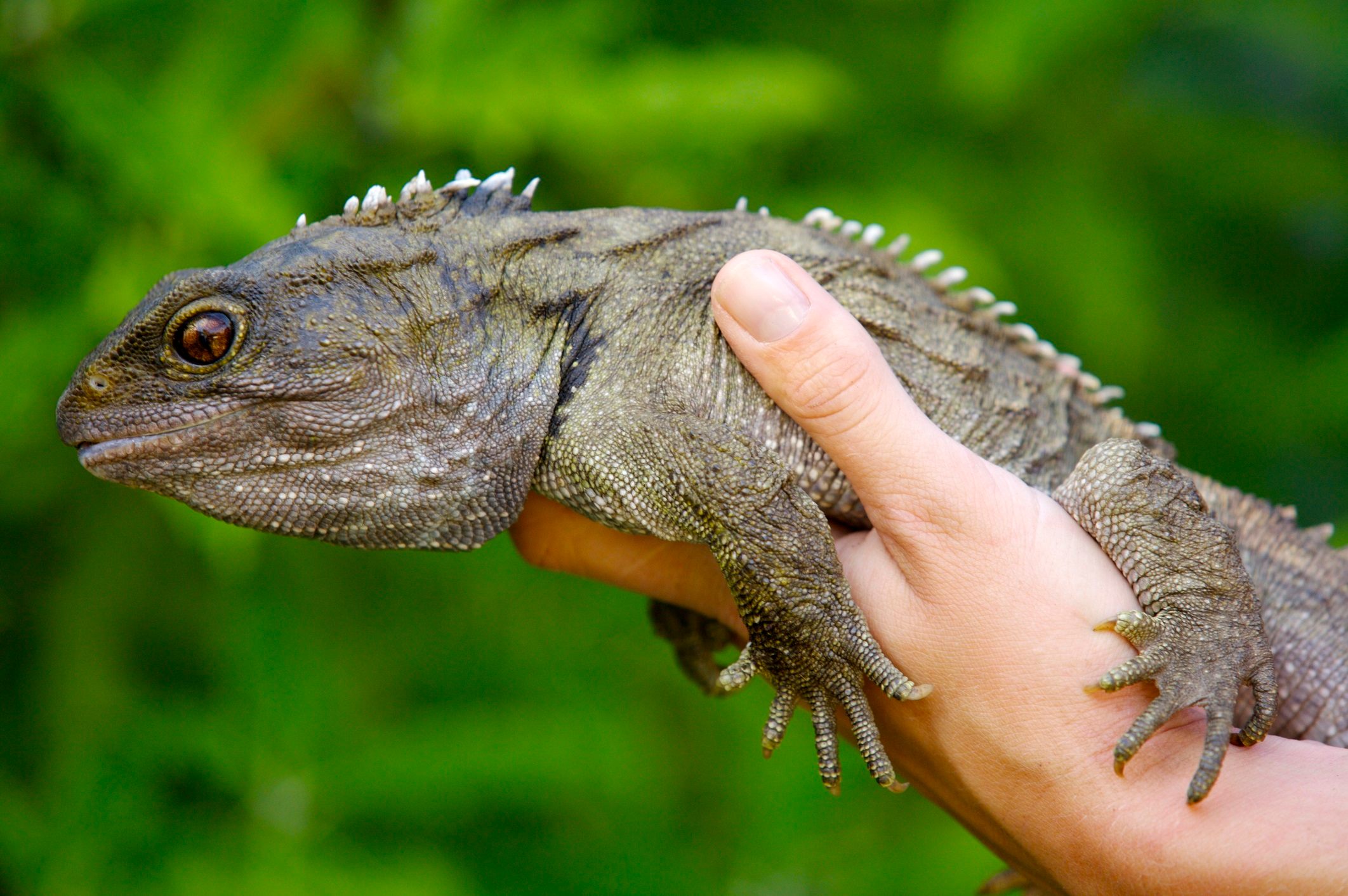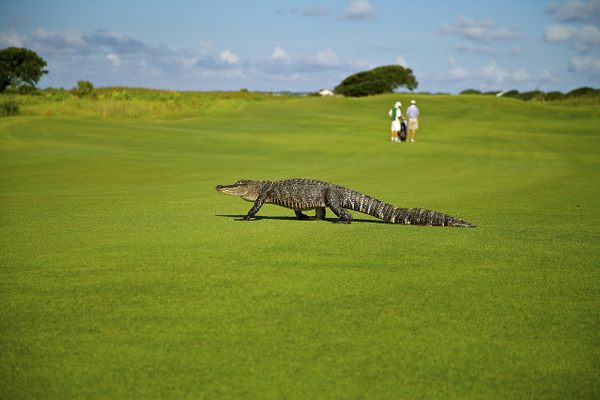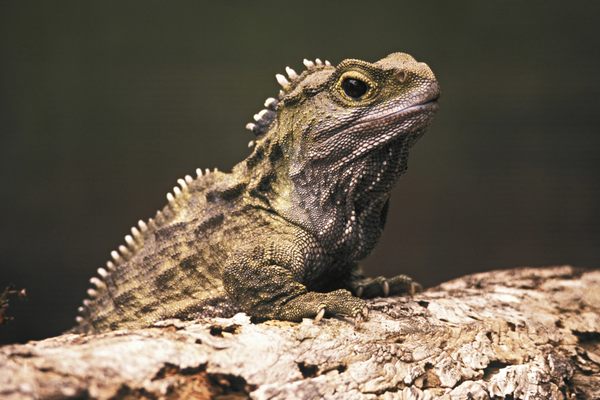The Unlikely Comeback of New Zealand’s Weirdest ‘Living Fossil’
Meet the tuatara, a three-eyed reptile with a 200-million-year-old lineage.

The tuatara should, by all rights, be extinct by now. The last living members of a 200-million-year-old family of reptiles called the Sphenodontia, the tuatara survived the cataclysm that wiped out the sphenodonts along with the dinosaurs and three-quarters of life on Earth, about 60 million years ago.
Today tuataras are stranded at the end of a broken branch on the evolutionary tree, an intriguing jumble of evolutionary clues and holdovers: Their skulls and sexual habits are birdlike, but they have the crude ears of a turtle and a brain like an amphibian’s. Their primitive hearts and lungs predate all of those. Strangest of all is the vestige of a “third eye” planted in the top of their skull like a scaly pimple.
Cold-blooded and slow-moving, the ancient reptiles—picture a sort of chubby, thick-tailed iguana about the length of your forearm—can only move at top speed for short bursts, after which they have to stop, winded and panting. Their hearts beat just six to eight times a minute, and they can go for years without eating. In the winter, they descend into hibernation so deep they seem dead. A newly hatched tuatara, roughly the size of a paperclip, may take more than 20 years before it’s old enough to reproduce—if isn’t eaten first. Even then, a female may only lay a clutch of eggs every few years.
Just don’t call them lizards. If the tuatara belongs with any group, it’s the “living fossils” —the obsolete species not yet informed of their obsolescence—like the coelacanth fish, the horseshoe crab, the nautilus, and the gingko tree. Native to New Zealand, tuataras were nearly wiped out by the rats that hitchhiked to the isolated continent with early Polynesian explorers. Rats out-ate and out-bred the lethargic reptiles across the mainland of New Zealand, and nearly all the outlying islands. Today, tuataras persist on only 35 small, rat-free islands, a fraction of their former habitat.

Now the nocturnal, burrowing reptiles are staging an unlikely comeback in the bulletproof-glassed “tuatararium” jutting from the back of the Southland Museum and Art Gallery, in the sleepy New Zealand city of Invercargill. The glass, along with an array of motion detectors and silent alarms, is there to dissuade any ambitious rare animal collectors who might think of skirting the law; the last one to try got away with two of the animals before he was tracked down and rewarded with a five-year prison sentence. Thefts aside, the museum’s breeding program has been so successful that, at the moment, it has more tuataras than it knows what to do with.
The icon of the museum’s success is Henry, the original male in the museum’s scale collection and holder of the tuatara record for lifespan in captivity. Henry has been living at Southland for 46 years, during which time he’s served as a kind of ambassador for New Zealand, Skyping into local classrooms and posing for photos with visiting dignitaries. No one knows how long tuataras live in the wild, but Henry is thought to be at least 80 years old, possibly more than 100—an extrapolation based on his size. At one point, his keepers guessed he could be as old as 111, but they’ve since scaled that estimate back down. These days, Henry holds court over more than 80 other tuataras, including 20 breeding females (like his namesake, Henry VIII, he’s not exactly a shining symbol of monogamy).
After living most of his life in cranky solitude, too aggressive to breed with the museum’s female tuataras, several years ago Henry finally had a cancerous tumor removed from his cloaca (the rudimentary reproductive organ shared by tuatara and modern birds). Suddenly, he was ready to make up for decades of lost time. One typical headline from the time: “Henry, 111, is finally in the mood.”
While Henry has recently retired from reproductive life—a product of both his decreasing fertility and the conundrum of conservation programs, where successful breeders are quickly overrepresented in a captive population’s limited genetic pool—his love life is emblematic of the unexpected success of the Southland Museum’s tuatara breeding program.
That has a lot to do with Lindsay Hazley, who has served as the museum’s tuatara caretaker for the last 44 years. Hazley, a tall, fast-talking man with close-cropped gray hair and a gangly athleticism that belies his sixty-some years, started volunteering at the museum as a high school truant ditching gym class. He worked odd jobs for the staff, setting up exhibits and hanging paintings, until they hired him straight out of high school. The job suited him. Hazley was put to work looking after the museum’s two tuataras, including Henry.

But since no one had really figured out how to raise tuatara in captivity, he was more or less left to experiment. Breeding was a particular problem, beyond Henry’s outright aggression (luckily for his prospective mate, Mildred, tuataras are capable of regenerating their tails). Captive tuataras often play coy and refuse to mate, or their eggs never hatch, or they hatch only for the baby tuataras to die after just a few days. Until recently, no zoo or program outside of New Zealand had managed to raise a tuatara from an egg.
Hazley’s breakthrough came from talking with a neonatal doctor. Since the museum’s tuataras lived in an enclosure sheeted in UV-blocking gardening plastic, they had trouble with uptake of vitamin D and calcium, losing bone mass and laying thin-shelled eggs that rarely hatched. So Hazley got a special light bulb used to treat premature babies and started to expose newly hatched tuataras to a couple of hours of UV-rich light every day.
After a few months of this, when the tuataras were returned to their UV-poor enclosure, they continued to thrive. Hazley theorizes that, just as premature babies need UV to regulate melatonin, a hormone that helps govern circadian rhythms, tuatara needed some help with their out-of-whack hormones. Whatever the reason, it seemed to work.
Now Hazley finds himself in an unusual predicament: Many of the tuataras he raises have nowhere else to go — not unless another zoo wants them, or until rat-eradication programs clear up more territory.
While New Zealand has put an extraordinary amount of money and effort into the fight against non-native mammals like rats, possums, and stoats, its ambitious goal of making New Zealand predator-free by 2050 still lacks the technology necessary to make it happen. So far, the country’s conservation department has verified 100 islands predator-free since efforts began to eradicate all mammalian invaders. National and regional pest control programs spend more than $70 million a year in trap maintenance, poison drops, and developing new technologies. If tuataras have a future, it hinges on finding more humane, efficient ways to kill rats.
Until then, the museum’s breeding efforts have ground to a halt. For the first time since he came to the museum 44 years ago, Hazley is just letting nature take its course.
Meanwhile Henry is getting on in age, whatever his is. These days, his only public appearances come in the form of the nearly life-size tattoo of Henry occupying Hazley’s right bicep. The tattoo, a 60th birthday present-slash-dare from his daughters, is a sign of the closeness between Henry and Hazley. The two have spent so much of their lives together that Henry reliably appears in his enclosure when he hears Hazley’s voice on the other side of the glass.
“He’s looking quite happy,” Hazley reported in October. He would know.
















Follow us on Twitter to get the latest on the world's hidden wonders.
Like us on Facebook to get the latest on the world's hidden wonders.
Follow us on Twitter Like us on Facebook